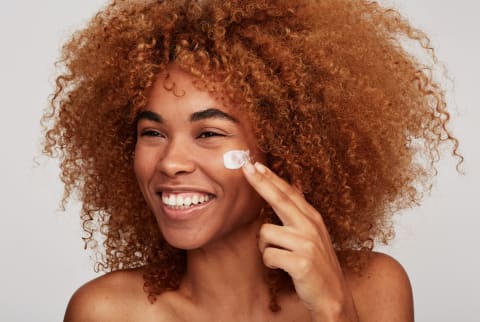Humectants, Emollients & Occlusives: What's The Difference?



I liken the world of moisturizers to a spectrum—it's not an exact comparison, but it does help you visualize it: On one end you have options that pull water into the skin, and on the other, there are those that act as a seal. And at various points on this spectrum, you have humectants, emollients, and occlusives—words you might see pop up in beauty stories or on a visit to a dermatologist's office. Understanding them is actually incredibly important—they dictate how you should use and layer your products. It's one of those concepts that once you understand, the world of skin care just makes more sense.
And the first thing you should know is that the below are categories of ingredients: each specifying a different set of qualities, board-certified dermatologist Keira Barr, M.D. tells me (who also medically reviewed this article). This is why you don't see a serum called a "Humectant Serum"; rather, it'll be identified as the specific ingredient itself, like "Hyaluronic Acid Serum." The other thing to note is these products are usually formulated with some combination of the three—unless you're putting a raw ingredient on your skin.
So let's dive into the specifics, shall we?
What's a humectant?
The most famous are hyaluronic acid and glycerin, but aloe, seaweed extracts, and lactic acid are also considered humectants. Ingredients that fall under the humectant umbrella work by pulling water into the skin and then holding it there. You might hear "hydrophilic" or "water-loving" tossed around in the same breath.
If the humidity is high enough, they can even pull water out of the air, but in arid environments, they might actually be pulling in water from the deeper layers of the dermis into the stratum corneum. This can end up being drying because once water is on the top layer of skin, it can more easily evaporate. For this reason, humectants are usually formulated with an occlusive1 (more on that below). If a product is not—take, for example, a straight hyaluronic acid serum—it likely shouldn't be used alone and instead should be layered under a cream or oil to help seal in the water.
What's an emollient?
An emollient is something that softens the skin and makes it feel more comfortable by filling in cracks. This is why emollients are often used for irritated, inflamed, or reactive skin2. Butters, certain oils, lipids, and fatty acids are all emollients. Emollients are also usually formulated with a humectant and occlusive, in order to perform its job better (as well as other ingredients entirely, like antioxidants; Barr notes that alone, they likely don't do enough for the skin). These products can range from light lotions, which contain more humectants, to thick creams, which likely contain more occlusives.
What's an occlusive?
The thickest end of the spectrum, these seal moisture into skin. In the natural world, these are your waxes like candelilla, carnauba, and palm kernel, beeswax, or lanolin ("traditional" examples include silicones and petroleum). They are also many types of oils, like jojoba or olive oils. Given they act as a water retention barrier, they also act as a barrier to outside forces: This is why they should be the last step of your routine. After you slick on an occlusive, anything layered on top isn't getting past it.
The takeaway.
Understanding the different types of moisturizers, and how they do their job of keeping skin hydrated, is essential. Once you know these key categories, you'll better understand the beauty world around you.

Alexandra Engler is the beauty director at mindbodygreen and host of the beauty podcast Clean Beauty School. Previously, she's held beauty roles at Harper's Bazaar, Marie Claire, SELF, and Cosmopolitan; her byline has appeared in Esquire, Sports Illustrated, and Allure.com. In her current role, she covers all the latest trends in the clean and natural beauty space, as well as lifestyle topics, such as travel. She received her journalism degree from Marquette University, graduating first in the department. She lives in Brooklyn, New York.